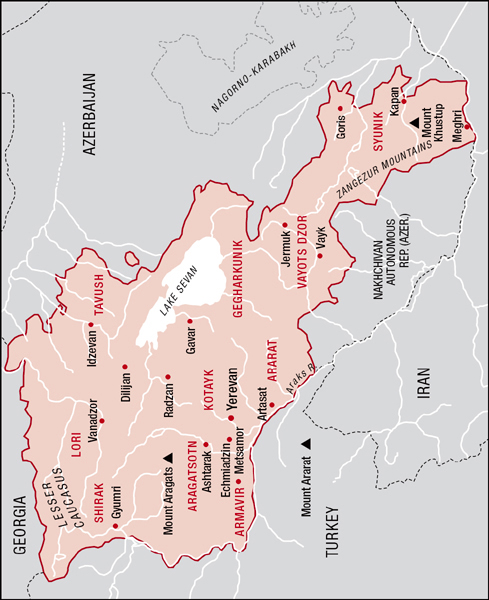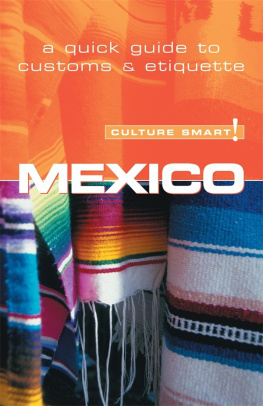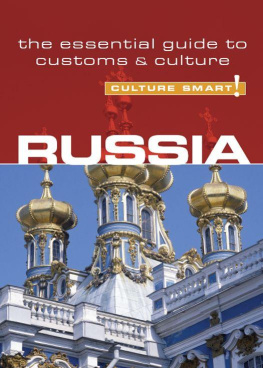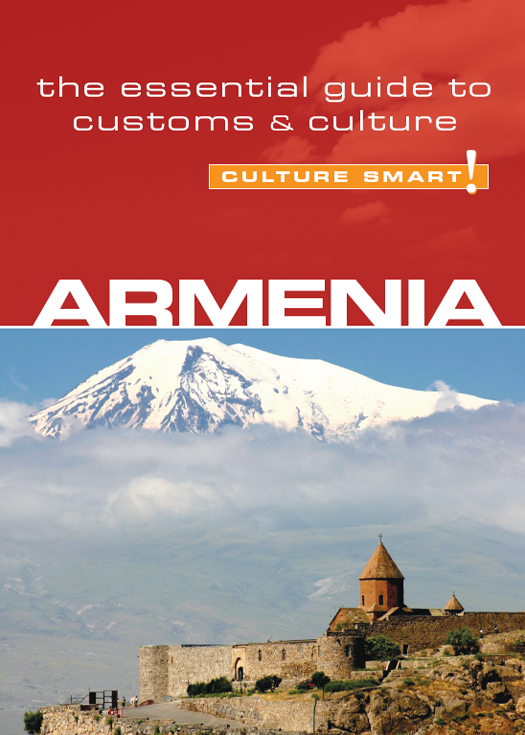First published in Great Britain 2010
by Kuperard, an imprint of Bravo Ltd
59 Hutton Grove, London N12 8DS
Tel: +44 (0) 20 8446 2440 Fax: +44 (0) 20 8446 2441
www.culturesmart.co.uk
Inquiries:
Culture Smart! is a registered trademark of Bravo Ltd
Copyright 2010 Kuperard
Revised 2011
All rights reserved. No part of this publication may be reprinted or reproduced, stored in a retrieval system, or transmitted in any form or by any means without prior permission in writing from the publishers.
Series Editor Geoffrey Chesler
eISBN: 978-1-85733-626-9
British Library Cataloguing in Publication Data
A CIP catalogue entry for this book is available from the
British Library
: Khor Virap Monastery with Mount Ararat in background.
Claudia Dewald/iStockphoto.com
The photographs on are reproduced by permission of the author.
Images on ;
; and
.
Images on the following pages reproduced under Creative Commons License Attribution
2.0, 2.5, and 3.0: Giovanni DallOrto;
Vigen Hakhverdyan;
Luciana;
avixyz;
Deror Avi
v3.1
About the Author
SUSAN SOLOMON has led the public relations and marketing programs of several large non-profit organizations. She has taught marketing, public relations, and writing at three Southern California universities, and in 2008 went to Armenia on a Fulbright scholarship to teach graduate-level marketing and public relations in Yerevan. To prepare for the journey she studied Armenian language and culture. Her family went with her, and her two children went to school in Yerevan.
Susan has written extensively in her field, and in 2005 published Building Powerful Health Care Brands. She has also written travel articles for the Los Angeles Times and is currently writing a novel.
The Culture Smart! series is continuing to expand.
For further information and latest titles visit
www.culturesmart.co.uk
The publishers would like to thank CultureSmart!Consulting for its help in researching and developing the concept for this series.
CultureSmart!Consulting creates tailor-made seminars and consultancy programs to meet a wide range of corporate, public-sector, and individual needs. Whether delivering courses on multicultural team building in the USA, preparing Chinese engineers for a posting in Europe, training call-center staff in India, or raising the awareness of police forces to the needs of diverse ethnic communities, it provides essential, practical, and powerful skills worldwide to an increasingly international workforce.
For details, visit www.culturesmartconsulting.com
CultureSmart!Consulting and CultureSmart! guides have both contributed to and featured regularly in the weekly travel program Fast Track on BBC World TV.
contents
Map of Armenia

introduction
On a map of the world today, the country of Armenia looks very small. It is about the size of Belgium, or the North American state of Maryland. Landlocked and mountainous, it is bordered by much larger neighborsTurkey, Azerbaijan, Georgia, and Iran.
Comparisons can be deceptive, however. This tiny nation in the Caucasus Mountains looms very large in the hearts of Armenians, both the three million living within the country and the eight million who are part of the worlds Armenian Diaspora. For the Armenian people, who have existed for five thousand years, sometimes without a country to call their own, the modern borders are simply artificial lines drawn by larger foreign powers in the early twentieth century. Geography is much less important than what it means to be Armenianto have created a proud culture, to have passed it down to ones children, and, most importantly, to have survived in tragic circumstances against almost unbelievable odds.
For the traveler to Armenia, some knowledge about the history and culture of the country is essential to appreciating its people. Culture Smart! Armenia provides a concise historical survey from ancient to modern times. More importantly, however, it addresses the way in which thousands of years of struggle have created a cultural memory that continues to define the Armenian people today.
The book looks at how its culture and history have influenced so many elements of modern Armenia, from family life to getting around the bustling streets of Yerevan and engaging in business. Armenians are far from impenetrable, but it is necessary to understand what makes them the way they are. Many of the people you will meet have survived the bitter days of the early 1990s, when war, blockages, shortages, and the aftermath of a terrible earthquake locked the country into desolation, deprivation, and darkness. They have seen and experienced it all.
Todays Armenia, like that of the past, is a place of challenge and triumph. Still emerging from economic hardship, it faces unemployment, environmental concerns, political unrest, closed borders, corruption, a wavering economy, and widespread emigration. Yet there are signs of change and a new eraconstruction, revival of the arts, and easing of tensions with the Turkish neighbors. You can also see the new Armenia by observing everyday life, from the lavish weddings and other celebrations that take place almost daily, to the attitude of its young people, who are determined to work hard, have fun, and contribute to their country.
Culture Smart! Armenia aims to broaden your understanding of a people whose cultural pride, welcoming nature, and enduring will are known far beyond the borders of their homeland. It will help you to avoid misunderstandings and to make your visit a memorable and rewarding experience.
Key Facts
| Official Name | Republic of Armenia Hayastan (Armenian name) | Declared independence from Soviet Union on September 21, 1991 |
| Capital City | Yerevan (pop. 1,107,800) |
| Other Major Cities | Gyumri, Vanadzor, Echmiadzin |
| Area | 11,484 square miles (29,743 sq. km). Landlocked in the Lesser Caucasus Mts. | Slightly smaller than the state of Maryland |
| Borders | Turkey, Azerbaijan, Georgia, and Iran. | Borders with Turkey and Azerbaijan currently closed |
| Terrain | Mountainous highlands, fast flowing rivers, few forests | Lake Sevan is the largest lake in the Lesser Caucasus range. |
| Climate | Highland continental; hot summers, cold winters | Look for the golden summer light around 3:004:00 p.m. |
| Economy | Agriculture 17.2% Industry 36.4% Services 46.4% (est.) | Natural resources: small deposits of gold, copper, molybdenum, zinc, bauxite |
| Currency | Dram (AMD) | 1 dram = 100 luma |
| Population | 2,967,004 (2009 est.); 64% of pop. live in towns and cities |






